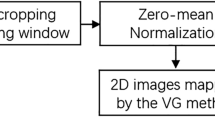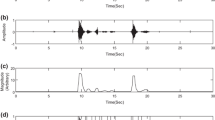Abstract
Snoring is a typical characteristic of obstructive sleep apnea hypopnea syndrome (OSAHS) and can be used for its diagnosis. The purpose of this paper is to develop an automatic snoring detection algorithm for classifying snore and non-snore sound segments, which have been segmented from a whole-night sleep sound signal using a spectral entropy method, based on convolutional neural network (CNN) descriptors extracted from audio maps. For each sound segment, the time-domain waveform, spectrum, spectrogram, Mel-spectrogram and CQT-spectrogram are calculated. Two classifiers are applied to classify sound segments into either snore or non-snore classes. The first classifier is referred to as CNNs–DNNs and combines CNNs and deep neural networks (DNNs), and the second classifier is referred to as CNNs–LSTMs–DNNs and consists of CNNs, Long and Short memory networks (LSTMs) and DNNs. The results show that the Mel-spectrogram can better reflect the differences between snore and non-snore sound segments for the five maps extracted in this study. Furthermore, the deep spectrum features extracted from CNNs–LSTMs–DNNs using Mel-spectrogram are well suited to this task. The results indicate that the method developed in this study could be used for a portable sleep monitoring device.





Similar content being viewed by others
References
Strollo PJ Jr, Rogers RM (1996) Obstructive sleep apnea. N Engl J Med 334(2):99–104
Lloberes P, DuránCantolla J, Martínez-García MÁ, Marín JM, Ferrer A, Corral J et al (2011) Diagnosis and treatment of sleep apnea-hypopnea syndrome. Arch Bronconeumol 47(3):143–156
Qian K, Janott C, Pandit V, Zhang ZX, Heiser C, Hohenhorst W et al (2016) Classification of the excitation location of snore sounds in the upper airway by acoustic multifeature analysis. IEEE Trans Biomed Eng 64(8):1731–1741
Zhao L, Huang XZ (2002) Overview of sleep snoring research. Chin Gen Pract 5(5):412–414
Abeyratne UR, Patabandi CKK, Puvanendran K (2001) Pitch-jitter analysis of snoring sounds for the diagnosis of sleep apnea. In: Proceedings of the 23rd Annual International Conference of the IEEE Engineering in Medicine and Biology Society, pp 2072–2075
Le Bon O, Staner L, Hoffmann G, Dramaix M, San Sebastian I, Murphy JR et al (2001) The first-night effect may last more than one night. J Psychiatr Res 35(3):165–172
Beattie ZT, Hayes TL, Guilleminault C, Hagen CC (2013) Accurate scoring of the apnea–hypopnea index using a simple non-contact breathing sensor. J Sleep Res 22(3):356–362
Emoto T, Abeyratne UR, Kawano K, Okada T, Jinnouchi O, Kawata L (2018) Detection of sleep breathing sound based on artificial neural network analysis. Biomed Signal Process Control 41:81–89
Pevernagie D, Aarts RM, Meyer DE (2010) The acoustics of snoring. Sleep Med Rev 14:131–144
Ip MSM, Lam B, Ng MMT, Lam WK, Tsang KWT, Lam KSL (2002) Obstructive sleep apnea is independently associated with insulin resistance. Am J Respir Crit Care Med 165(5):670–676
Aldrich MS (1999) Sleep medicine. Springer, New York, USA
Perez-Padilla JR, Slawinski E, Difrancesco LM, Feige RR, Remmers JE, Whitelaw WA (1993) Characteristics of the snoring noise in patients with and without occlusive sleep apnea. Am Rev of Respir Dis 147(3):635–644
Fiz JA, Abad J, Jané R, Riera M, Mananas MA, Caminal P et al (1996) Acoustic analysis of snoring sound in patients with simple snoring and obstructive sleep apnea. Eur Respir J 9(11):2365–2370
Sola-Soler J, Jane R, Fiz JA, Morera J (2003) Spectral envelope analysis in snoring signals from simple snorers and patients with obstructive sleep apnea. In: Proceedings of the 25th Annual International Conference of the IEEE Engineering in Medicine and Biology Society, pp 2527–2530
Ng AK, Koh TS, Baey E, Lee TH, Abeyratne UR, Puvanendran K (2008) Could format frequencies of snore signals be an alternative means for the diagnosis of obstructive sleep apnea. Sleep Med 9(8):894–898
Duckitt WD, Tuomi SK, Niesler TR (2006) Automatic detection, segmentation and assessment of snoring from ambient acoustic data. Physiol Meas 27(10):1047–1056
Cavusoglu M, Kamasak M, Erogul O, Ciloglu T, Serinagaoglu Y, Akcam T (2007) An efficient method for snore/nonsnore classification of sleep sounds. Physiol Meas 28(8):841–853
Dafna E, Tarasiuk A, Zigel Y (2013) Automatic detection of whole night snoring events using non-contact microphone. PLoS ONE 8:e84139
Nguyen TL, Yonggwan W (2015) Sleep snoring detection using multi-layer neural networks. Biomed Mater Eng 26:1749–1755
Mikami T, Kojima Y, Yonezawa K, Yamamoto M, Furukawa M (2013) Spectral classification of oral and nasal snoring sounds using a support vector machine. J Adv Comput Intell Intell Inform 17(4):611–621
Goswami U, Black A, Krohn B, Meyers W, Iber C (2019) Smartphone-based delivery of oropharyngeal exercises for treatment of snoring: a randomized controlled trial. Sleep Breath 23(1):243–250
Wang C, Peng JX, Song LJ, Zhang XW (2016) Automatic snoring sounds detection from sleep sounds via multi-features analysis. Australas Phys Eng Sci Med 40(1):1–9
Samuelsson LB, Rangarajan AA, Shimada K, Krafty RT, Buysse DJ, Strollo PJ, Kravitz HM, Zheng HY, Hall MH (2017) Support vector machines for automated snoring detection: proof-of-concept. Sleep Breath 21(1):119–133
Khan T (2019) A deep learning model for snoring detection and vibration notification using a smart wearable gadget. Electronics 8(9):987
Abeyratne UR, Wakwella AS, Hukins C (2005) Pitch jump probability measures for the analysis of snoring sounds in apnea. Physiol Meas 26(26):779–798
Wu PP, Zhao G, Zhou M (2008) Improved spectral subtraction based on multi-window spectrum estimation. Mod Electron Technol 12:150–152
Yi H, Loizou PC (2004) Speech enhancement based on wavelet thresholding the multiaper spectrum. IEEE Trans Speech Audio Proc 12(1):59–67
Scalart P, Filho JV (1996) Speech enhancement based on a priori signal to noise estimation. In: 1996 IEEE international conference on acoustics, speech, and signal processing conference proceedings. IEEE, pp 629–632
New TL, Tran HD, Ng WZT, Ma B (2017) An integrated solution for snoring sound classification using Bhattacharyya distance based GMM supervectors with SVM, feature selection with random forest and spectrogram with CNN. Proc Interspeech 2017:3467–3471
Amiriparian S, Gerczuk M, Ottl S, Cummins N, Freitag M, Pugachevskiy S et al (2017) Snore sound classification using image-based deep spectrum features. Proc Interspeech 2017:3512–3516
Rabiner LR, Gold B, Yuen CK (1978) Theory and application of digital signal processing. IEEE Trans Syst Man Cyber 23(2):146–146
Brown JC, Puckette MS (1992) An efficient algorithm for the calculation of a constant Q transform. J Acoust Soc Am 92(5):2698–2701
Schorkhuber C, Klapuri A. Constant Q transform toolbox for music processing. In: 7th Sound and Music Computing Conference, Barcelona, Spain, pp 210–217
Brown JC (1991) Calculation of a constant Q spectral transform. J Acoust Soc Am 89(1):425–434
Todisco M, Delgado H, Evans N (2016) A new feature for automatic speaker verification anti-spoofing: constant Q cepstral coefficients. In: Proc. ISCA Odyssey, pp 283–290
Qian K, Xu ZY, Xu HJ, Wu YQ, Zhao Z (2015) Automatic detection, segmentation and classification of snore related signals from overnight audio recording. IET Signal Proc 9(1):21–29
Abdel-Hamid O, Mohamed A R, Jiang H, Penn G, Yu D (2012) Applying convolutional neural networks concepts to hybrid NN-HMM model for speech recognition. In: 2012 IEEE International Conference on Acoustics, Speech and Signal Processing (ICASSP), pp 4277–4280
Abdel-Hamid O, Mohamed AR, Jiang H, Deng L, Penn G, Yu D (2014) Convolutional neural networks for speech recognition. IEEE/ACM Trans Audio Speech Lang Process 22(10):1533–1545
Sainath TN, Vinyals O, Senior A, Sak H (2015) Convolutional, long short-term memory, fully connected deep neural networks. In: 2015 IEEE International Conference on Acoustics, Speech and Signal Processing (ICASSP), pp 4580–4584
Liu SY, Deng WH (2015) Very deep convolutional neural network based image classification using small training sample size. In: 2015 3rd IAPR Asian conference on pattern recognition (ACPR), pp 730–734
Peng C, Zhang XY, Yu G, Luo GM, Sun J (2017) Large Kernel matters—improve semantic segmentation by global convolutional network. In: Proceedings of the IEEE conference on computer vision and pattern recognition, pp 4353–4361
Acknowledgements
This work was supported by National Natural Science Foundation of China (81570904, 11974121).
Author information
Authors and Affiliations
Corresponding authors
Ethics declarations
Conflict of interest
The author(s) declared no potential conflicts of interest with respect to the research, authorship, and/or publication of this article.
Ethical approval
This study was approved by the Ethics Committee of Guangzhou Medical University and an informed consent was obtained from each participant.
Additional information
Publisher's Note
Springer Nature remains neutral with regard to jurisdictional claims in published maps and institutional affiliations.
Rights and permissions
About this article
Cite this article
Jiang, Y., Peng, J. & Zhang, X. Automatic snoring sounds detection from sleep sounds based on deep learning. Phys Eng Sci Med 43, 679–689 (2020). https://doi.org/10.1007/s13246-020-00876-1
Received:
Accepted:
Published:
Issue Date:
DOI: https://doi.org/10.1007/s13246-020-00876-1




